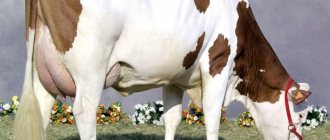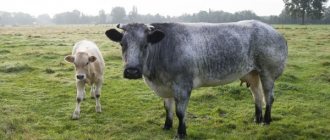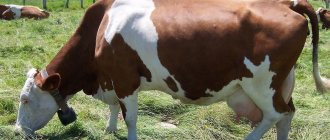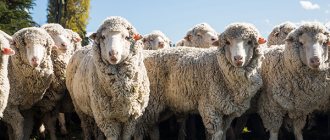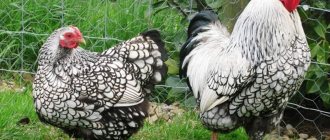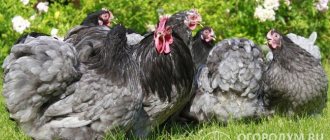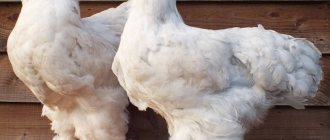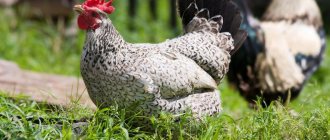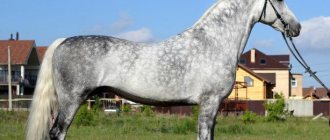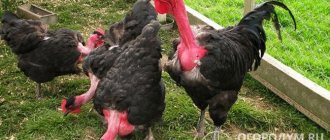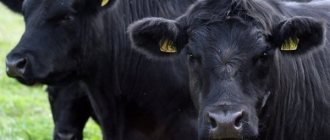History of the species
— Advertising —
As the name suggests, Jersey cows originated on the island of Jersey. This is the largest of the Channel Islands, which is located in the English Channel, between England and France.
The area of the island is about 120 square kilometers. It is famous as a tourist and banking center, as well as for Jersey Royale potatoes and, of course, the Jersey cow.
Sixty years ago, there were no more than 1,000 houses on this small island, but each of them kept at least a couple of Jersey cows. Today, there are at least 30 operating farms on the territory that specialize in breeding the species. The basic genetics of the Jersey breed are believed to originate in Africa. This explains why the species is resistant to heat and humidity.
— Advertising —
Jersey owners emphasized the development of a breed of cows with a high content of dry matter in milk. This selection over several generations has created a cow with an unusually high milk fat content, which distinguishes it from other common breeds of cattle.
For 200 years, the import of live cows, sperm or embryos into the island was restricted. Therefore, the breed is known for its ability to reproduce naturally. The ban on the import of semen from other animals into Jersey was lifted in July 2008.
For much of the first six decades of the 20th century, the island was the source of Jersey breeding stock around the world. The breed was in demand in New Zealand, Australia, Denmark, the United States, South Africa, Great Britain and Canada.
More recently, these countries have become a source of seed for national herds in Central and South American countries such as Brazil, Guatemala, Argentina, Peru, Uruguay, Colombia, Venezuela and Costa Rica. Mexico also became an importer and breeder of the species. Jersey cow numbers are growing in France, Japan, Germany, Italy, the Netherlands, Switzerland and Kenya.
Caring for a newborn calf
After the calf is born, it needs to be given a sufficient amount of mother's milk. The longer you feed him milk, the stronger he will be. A week after birth, the calf needs to be given at least three liters of milk per feeding. The number of feedings is at least three times a day. In the intervals between feedings, the baby needs to be given a liter of salted water.
When the calf is a week old, they begin to introduce a little hay into its diet, sprinkled with a handful of chalk on top. This substance helps strengthen the baby’s joints and bones.
When the calf is one month old, well-washed vegetables are gradually introduced into its menu. It is allowed to give the baby vegetables such as potatoes, beets, rutabaga. Gradually, it is necessary to introduce more and more vegetables and hay, then add a little feed. Milk is still given to the calf, but diluted in half with water.
The calf should be given whole milk until it is two months old. At this time, the stomach adapts to adult food, so there is no need to be afraid to give hay and vegetables. Useful additions to the menu are salt and red clay. Drinking regime must always be observed. The calf is given no more than three liters of water at a time.
Important! Additionally, it is necessary to carefully monitor the cleanliness of the sleeping place of mother and baby, treat it at least once every few days with disinfectants, and clean it of dirt.
Description of the Jersey breed
The Jersey breed of cows is comparatively smaller than other dairy species. The head is relatively long, the muzzle is wide. The eyes are placed far from each other, the forehead is narrow. The body of the species is muscular, the udder is large.
Both bulls and cows have thin and curved horns on their heads.
The characteristics of the Jersey cow breed say that modern animals come in different colors. As a rule, these are shades of fawn, but sometimes there are also gray, reddish, white or even black. Regardless of color, a cow's belly is lighter in color. Both bulls and heifers are darker in the hips, head and shoulders.
Jerseys have 32 teeth. The difference from humans is that the animal has 8 incisors in the lower jaw in front and 6 strong molars on the upper and lower jaws.
The Jersey cow breed is docile in temperament.
The average body weight of mature cows varies from 400 to 500 kg. Adult bulls weigh on average from 540 to 820 kg.
The table shows the average weight of heifers, depending on age:
| Age, months | Weight, kg | Height, cm |
| 1 | 48 | 78 |
| 2 | 66 | 83 |
| 3 | 83 | 89 |
| 4 | 100 | 93 |
| 5 | 117 | 97 |
| 6 | 135 | 101 |
| 7 | 152 | 104 |
| 8 | 169 | 107 |
| 9 | 187 | 110 |
| 10 | 204 | 113 |
| 11 | 221 | 115 |
| 12 | 239 | 117 |
| 13 | 256 | 118 |
| 14 | 273 | 120 |
| 15 | 290 | 121 |
| 16 | 308 | 122 |
| 17 | 325 | 123 |
| 18 | 342 | 124 |
| 19 | 360 | 125 |
| 20 | 377 | 126 |
| 21 | 394 | 127 |
| 22 | 411 | 128 |
Health
Possible problems
Nature and genetics have awarded Jersey cows with good health. Even joint diseases of the limbs, common among other varieties of cows, rarely bother Jerseys.
Purebred representatives of the breed have weak immunity to the nematode worm that lives in water. Together with drinking, the larva enters the digestive system of the cow, causing hemonchosis. To prevent the disease, veterinarians prescribe anthelmintic drugs. They are given at the end of February or beginning of March.
In dry and hot weather, the skin of cows is attacked by gadflies. Due to the discomfort caused by the beetles, animals experience stress. Accordingly, they bring less milk. Gadflies are repelled by chlorophos, which is used to treat the skin of cows.
Vaccination and disinfection
When the calf reaches the age of 1.5 months, the vaccination period begins. The first vaccination includes protection against colibacillosis. The next one, for rabies, is diagnosed in three weeks.
Subsequent vaccinations are given at intervals of 12-14 days: against anthrax, salmonellosis, trichophytosis. After a year, vaccinations are carried out against foot and mouth disease, theileriosis, pasteurellosis, and brucellosis.
If necessary, vaccinations against rabies and anthrax are repeated. Annual vaccination is mandatory, which is carried out two weeks before the conception of offspring.
Complete disinfection of the barn is carried out every six months. The procedure will help eliminate many diseases, including helminths.
Characteristics of Jersey cows
The value of the Jersey cow lies in its milk. It has a creamy, mild, pleasant taste, and also contains more protein, calcium and other nutrients than milk from other breeds. Jersey is the most efficient dairy producer in the world. The animal produces more liters of milk and cheese per kg of body weight than any other type of cow.
The fat content of milk ranges from 3.3 to 8.4%, with an average of about 5.3%. For comparison, in the Holshin breed these figures average 3.5%. The dry matter content of the jersey product is about 15%.
Milk contains a lot of carotene, which gives it a creamy or yellowish color. The product also contains fat globules, the diameter of which is, on average, 25% larger than that of the Holshines.
Content Features
Jersey cattle are unpretentious in maintenance and care. In summer, take care of regular walks in the pastures. In winter - a warm, ventilated room, as well as a sufficient amount of food. It is noted that the Jersey species does not like noisy environments.
The Jersey breed of cows adapts to any climate. Due to its size, the cow consumes 25-30% less feed compared to other dairy species.
Ruminant animals need to receive nutrients daily.
The main component of nutrition is protein. Its lack in the diet of a dairy Jersey cow leads to a decrease in milk yield, deterioration of fertility, and poor immunity. As a result, susceptibility to diseases increases, metabolism is disrupted, and so on.
A cow may not receive enough protein in the following cases:
- In early spring.
- In midsummer during a drought.
- Low protein feed. Examples include corn, grain silage, fodder beet and concentrates such as citrus pulp.
It is also important for animals to receive vitamins and minerals, such as calcium and phosphorus. Although the cow's skeleton contains reserves of both elements, their imbalance leads to infertility.
The daily micronutrient requirements of dairy breeds are as follows:
| Element | Requirement, mg |
| Copper | 150-400 |
| Selenium | 3-5 |
| Iodine | 12-50 |
| Cobalt | 5-10 |
| Magnesium | 335-415 |
| Zinc | 335-750 |
Animals that eat green pastures receive all the necessary nutrients and vitamins. Vitamins are added to balanced diets during the winter months.
Give animals fresh water 2 times a day.
Feeding
These cows graze well, but do not ruin the pastures at all, being content with a quite moderate amount of grass.
For this reason, small-sized Jerseys require less purchased feed (mixed feed, etc.), which allows you to save a lot on their maintenance.
In addition to fresh grass and feed, cows should also be fed hay and washed vegetables. As many cattle breeders note, it is necessary to ration water consumption for these animals.
If adult cows and bulls are still able to restrain their water appetites, then for some reason calves have an insatiable interest in drinking water. If they are not limited to 3-4 liters of water per day, they will certainly have problems with digestion.
It is best to feed livestock in winter with high-quality hay. Concentrates, mixed feed, straw and root vegetables are suitable as a supplement.
Dried corn and corn stalks are beneficial for the breed. Cake, vegetables, and silage can be used as feed, although such a diet is not typical for this breed due to its origin.
For the first 20 days after calving, the cow should not be given green, succulent feed, otherwise the amount of milk will sharply decrease. At this time, the cow is fed exclusively with dry feed, and drinking water is provided separately.
Breeding Jersey cows
The early maturity of the Jersey species occurs at 2-3 years of age. Pregnancy and birth in a cow occur without complications, so no human intervention is required. The weight of Jersey calves immediately after birth is about 19-20 kg.
Take care of your newborn baby. To do this, follow these rules:
- Place the newborn near the mother's muzzle, the heifer will lick the calf after birth.
- If this does not happen, then wipe the calf with straw yourself.
- Then take the baby away so the mother can rest.
- The first milk after childbirth is called colostrum and is given to the newborn.
- During the first 30 days, the calf is given milk.
- When babies reach one month of age, washed vegetables are also introduced.
- After reaching two months, the calf is allowed to go to pastures with other animals.
Also, don’t forget about mommy - she also requires care. Immediately after giving birth, she will produce more milk, so increase the frequency of milk production. Milk the heifer five times in the first four days after birth, and four times the next ten days.
average cost
It is difficult to find a purebred Jersey cow ; only large farms in the Russian Federation are interested in buying and selling representatives of the breed. The average cost of a calf is 19-20 thousand rubles.
Buying a mixed breed will be cheaper (13-15 thousand rubles), but the quality and quantity of milk yield from such an individual may not live up to expectations.
Finding a purebred Jersey cow is difficult
The value of the Jersey breed
- The cost of maintaining a Jersey is less compared to other breeds.
- The cow has no problems with calving, high fertility and early maturity.
- Jersey milk has high nutritional value, as well as the highest yields of cheese and cottage cheese.
- Jersey milk contains 18% more protein, 20% more calcium and 25% more fat compared to other animals.
- Animals are known to be less susceptible to lameness due to the black color of the hooves, which makes them hard.
- Jersey products are highly valued in the market.
- Good temperament is important for a dairy cow. An animal that behaves poorly causes unwanted delays in milk yield as well as damage to expensive equipment. Jerseys are considered to have one of the best temperaments among dairy breeds, although behavior also depends on how the animals are handled.
Diseases and their treatment
The breed is not very susceptible to cow diseases (for example, mastitis). If the breeder fulfills all sanitary and hygienic standards, the herd usually does not get sick.
Only if there are pockets of infection in the area can cows suffer from diseases such as leptospirosis, leukemia, and actiminosis. If the rules of herd maintenance are violated, cows can also develop helminthiasis.
If signs of any disease appear in cows or bulls, the breeder should immediately contact a veterinarian for qualified help.
Until the end of treatment, animals must be isolated from the general herd, both in barns and in walking areas, in order to avoid infection of the livestock.
Jersey in different countries
- Denmark. The country has the largest Jersey population in Europe: 64,000 purebred animals. The breed represents about 13% of Danish dairy cattle. According to the 2008 national figure, cows produced 6,564 kg of milk with 384 kg of fat (5.85%), 264 kg of protein (4.02%). Denmark is the main exporter of semen and Jersey stock to most of continental Europe. In 2008, the Danes exported 260,000 doses of semen and 1,040 heifers to 34 countries.
- New Zealand. The country has the largest population of Jerseys in the world, with approximately 800,000. As of June 2005, there are 580,000 dairy cows in the national herd
Famous Jersey cows
- Jersey Mainstream Berretta Joy is a US and World champion milk producer. The productivity of this Jersey cow was about 20.4 tons of milk in 365 days, when milked 2 times a day.
- Brown Bessie is the Dairy Test Champion at the Chicago World's Fair. On average, the heifer received more than 18kg of milk per day for five months, which was converted into 1.3kg of butter.
- An animal named Evie played a major role in the film First Cow in 2022.
Owner reviews
Alexey, 41 years old, Tula region
I got this cow 4 years ago. So far I haven't been disappointed. There have already been two calvings, without any complications. The milk is excellent both in taste and in fat content: the cream, when settled, takes up almost a third of the jar’s volume. Now we have our own sour cream and cottage cheese. We bought sourdough and are making cheese. Milk yield cannot be called high (12-13 liters per day), but we use milk only for ourselves, and with such quality it’s a sin to complain. Now the young chick is growing up, there is a chance to “expand” a little.
Irina, 63 years old, Moscow region
I had a Jersey heifer several years ago, but I had to sell it. The fault lies solely with me: I spoiled the animal. They are so beautiful when they are little, everyone caresses and cuddles them. So I didn’t follow: the grandchildren were fiddling with her like a soft toy. She became attached to them, but her character deteriorated. When she grew up, she became nervous and aggressive. She offended all the living creatures in the yard, and it was difficult for them to let me in, so I couldn’t cope. And yet, I want a cow of this breed. Perhaps I’ll still decide to start one.
Semyon, 59 years old, Krasnodar region
I already have two Jerseys. Keeping them is easy and profitable. I plan to buy a bull to increase the herd. It will most likely not be cheap, and you will still have to look for a reliable seller who will not deceive you with pure blood, but it will be worth it. Good butter and cheeses are becoming more expensive all the time, and the milk of these cows is an ideal raw material for the production of products of this kind. I want to organize my own processing and sales.

